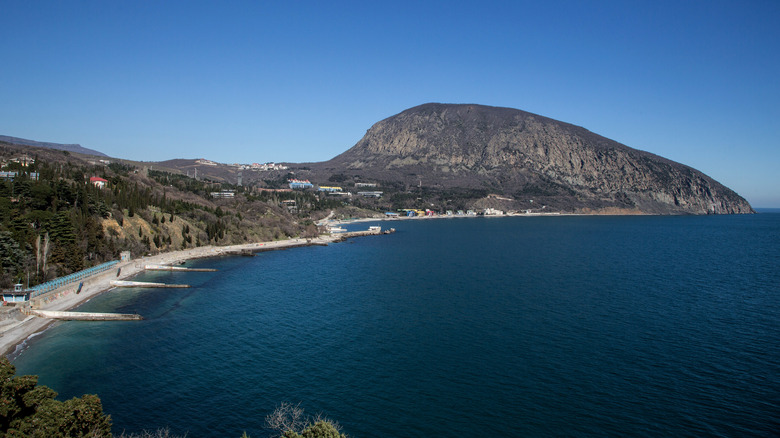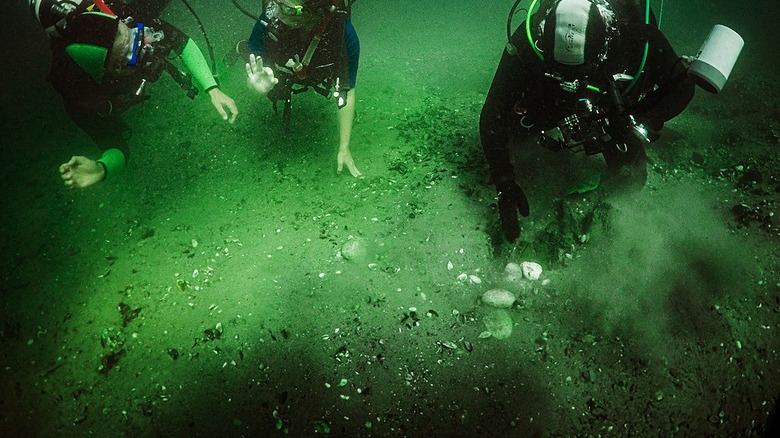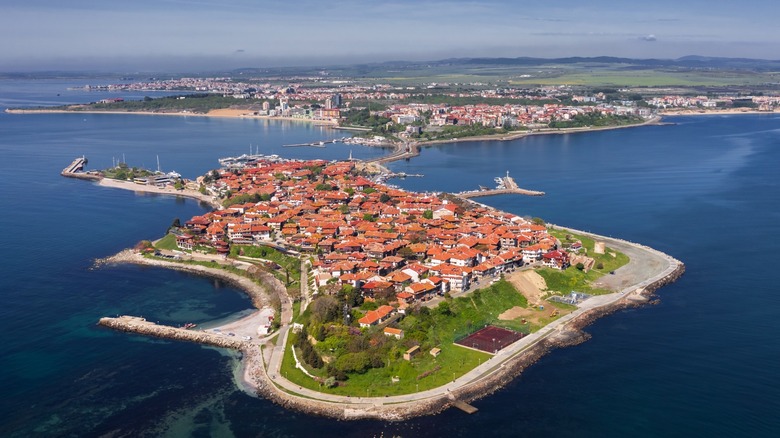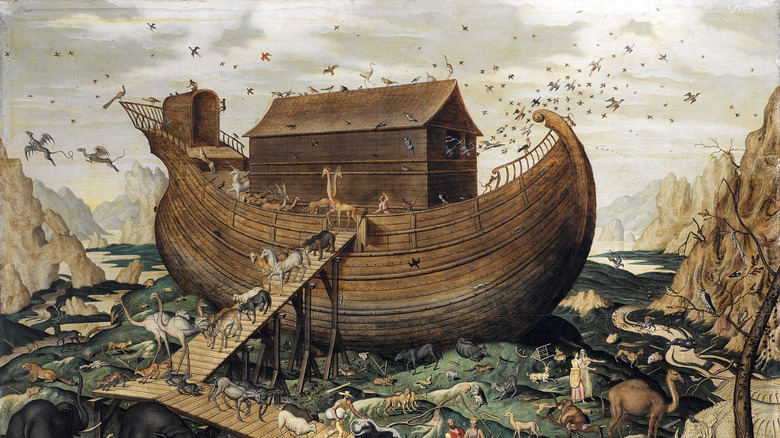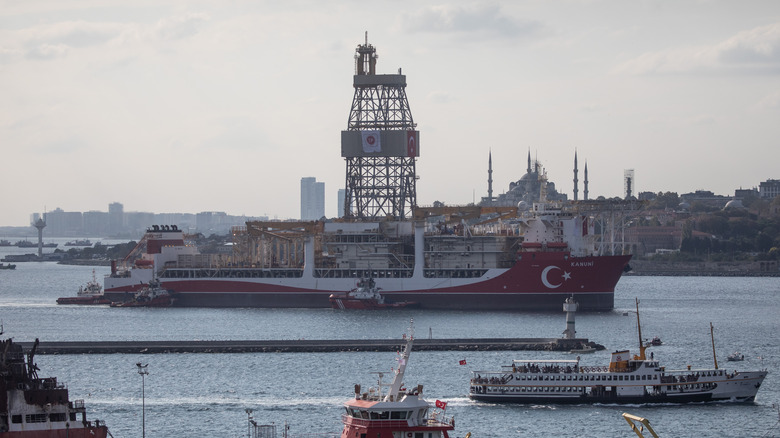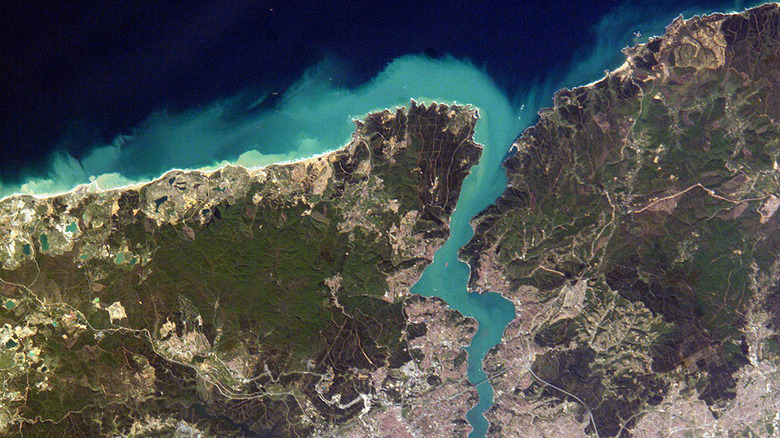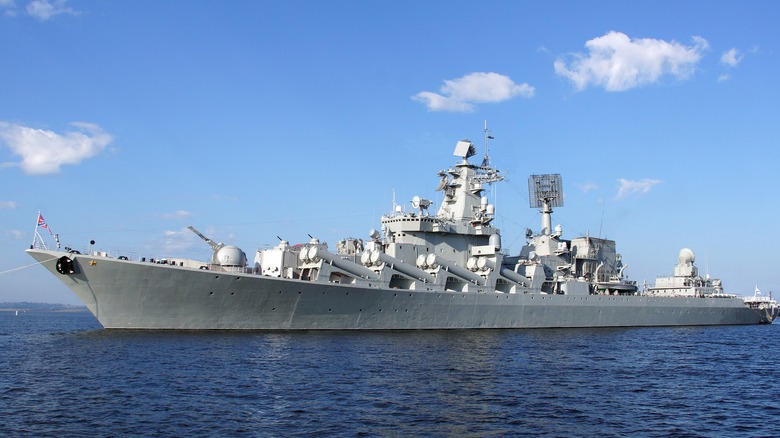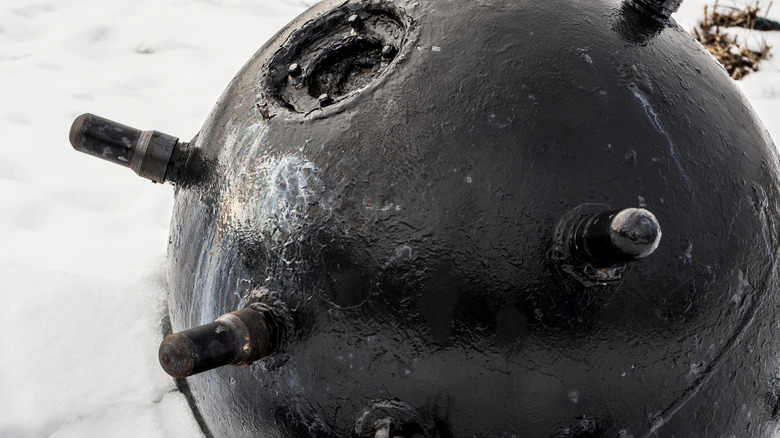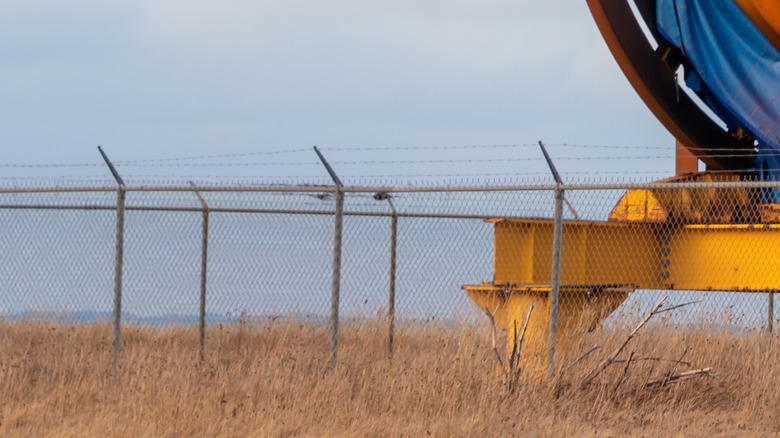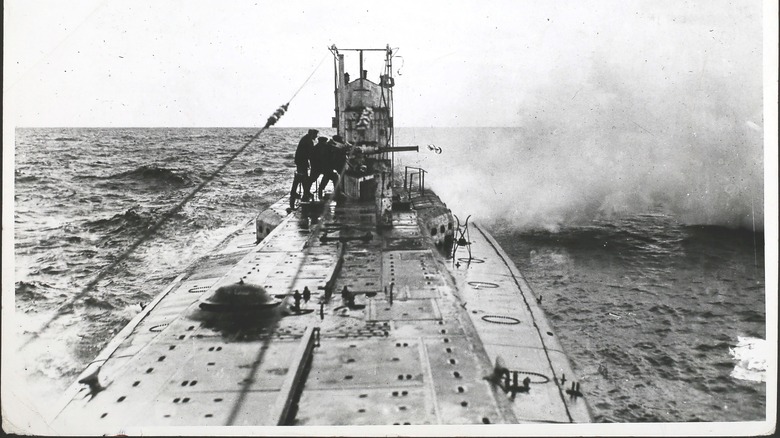Things Found At The Bottom Of The Black Sea
Robert Ballard, who found fame for discovering the Titanic, called the Black Sea a "magical place" in an interview with the BBC. Even in antiquity, the sea had this reputation. According to Livius, the Romans called it Pontus Euxinus, a euphemistic change to the original Greek name Pontos Auxenos (via Greece & Rome). Its rocky coasts were steeped in mystery and legend, inhabited by warlike tribes with a dislike for Greek outsiders seeking to colonize its shores — so the tales went.
Today, the Black Sea is known for being one of the best-preserved sailors' graveyards, where over 60 well-preserved shipwrecks have been discovered that shed light on the sea's history from classical times to the present. But the Black Sea is also a connector, and the nations that control its shores rely on it for telecommunications, gas, and commerce.
Anoxic water
According to the University of Washington, the Black Sea is a heavily-stratified water body with three different layers of water that do not mix. This is in part due to its past history as a freshwater lake and its supply of salinated water. As the university notes, the Black Sea receives its water from two main sources. From the Bosphorus Plume, the Sea of Marmara, the Aegean, and eventually the Mediterranean, it receives a supply of salinated water. But it also receives a supply of fresh water from the numerous rivers that pass through Eastern Europe, such as the Dniester, the Danube, and the Dnieper.
The higher density of salt water creates a stratification in the Black Sea that keeps the layers from mixing. The top layer is less-salinated and well-oxygenated and supports a host of life forms. The bottom layer is anoxic, meaning that it contains little to no dissolved oxygen and is instead rich in hydrogen sulfide, making it inhospitable to most life forms. In between is what is known as a suboxic layer with little oxygen or hydrogen sulfide. This makes the Black Sea an interesting case study because its anoxic layers are believed to represent earth's inhospitable ancient oceans, which became more hospitable to oxygen-breathing life as the planet's atmospheric oxygen increased. The lack of oxygen is also believed to make the Black Sea a great preserver of organic matter such as shipwrecks.
Anaerobic bacteria
The toxicity of the Black Sea's suboxic and anoxic layers is the result of hydrogen sulfide-producing bacteria (via the University of Wagingen). This chemical is a toxic gas that can cause asphyxiation if inhaled — at least for humans and other mammalian life forms. But there are smaller life forms that have evolved to thrive in this toxic environment that use hydrogen sulfide as part of their food source.
According to a short study published in PNAS, researchers took a sample of suboxic water from the Black Sea where the suboxic and anoxic layers meet. The samples were then dosed with hydrogen sulfide or thiosulfate, a less-toxic sulfate that was safer to use in the lab. After some time observing, the researchers noted that an autotrophic bacterial colony had grown in this otherwise-inhospitable cocktail. They dubbed the bacteria "Sulfurimonas marisnigri," and it seemed to love the sulfurous environment because it could use hydrogen sulfide for food synthesis. The reaction oxidizes hydrogen sulfide with manganese oxide and produces sulfate. In this regard, the different types of bacteria are in symbiosis. The hydrogen sulfide-producing bacteria create the environment that allows other species — such as Sulfurimonas marisnigri — to thrive.
The world's oldest known shipwreck
As noted by the University of Washington, the anoxic environment of the Black Sea's deepest layers seem to preserve organic matter very well. The precise reasons are still debated, but there is no doubt that the Black Sea has a much larger number of well-preserved shipwrecks than most places — including the oldest known one. In 2018, the BBC reported that an Anglo-Bulgarian team had discovered a 2,400-year-old classical Greek shipwreck off the coast near the Bulgarian city of Burgas. While the archaeologists assumed it was a trade ship, most of the cargo was not immediately accessible because it was inside the ship's hold.
While the exploration of the ship itself was put on hold for lack of funding, there are some clues from Greek vase paintings that give an idea of the ship's mission. A vase from around 500 B.C. depicts the Mycenaean Greek hero Odysseus being tied to the mast of his ship so he can listen to the song of the tempting Sirens without jumping to his death on their jagged rocks from his desire to be with the seductresses. Per the researchers, the ship on the vase is similar to a wreck found in the Black Sea, suggesting that the disaster dates to at least 500 B.C. Its purpose? Given where it was found and the presence of Greek colonies on the Black Sea coast, it was a trade ship that conducted long-distance commercial voyages between the colonies, the Aegean, and the Mediterranean. But only an exploration of the ship's hull contents can confirm this with certainty.
A submerged town
According to Bulgaria's Center for Underwater Archaeology, the resort town of Nessebar has a storied history as much more than a vacation spot. According to Unesco, the town traces its roots back to a Bronze Age Thracian settlement called Menebria that eventually became the Greek city of Mesembria. It went back and forth between Bulgarian and Byzantine rule before eventually becoming part of the Ottoman Empire and then Bulgaria, where it remains today. The city is interesting not only because it contains over 3,000 years of civilization in layers built one on top of the other but also because one-third of the city — including some of its grandest sights — is underwater.
According to the various excavators, Nessebar was vulnerable to erosion, landslides, and earthquakes that resulted in flooding when accompanied by rising sea levels. Part of this, however, was actually the fault of the builders. The city was in part built on unstable sandstone that the Black Sea gradually eroded away, sinking whatever was built on top of it. And they were not small structures either — Bulgarian archaeologists have found the remains of a theater, a temple to the Greek pantheon's royal couple Zeus and Hera, and even an early Christian basilica.
A Neolithic village
The story of Noah's Ark has led researchers to try and find the truth about the tale. According to the Smithsonian, many extra-biblical cultures have some form of the tale, so archaeologists and Bible enthusiasts alike have concluded that it must be based on a true event. Notably, Columbia University geologists William Ryan and Walter Pittman have suggested that the Black Sea lies at the center of Noah's story. Until around 7,000 years ago, the Black Sea was a smaller freshwater lake with thriving Neolithic communities on its shores. According to MIT, one of these possible sites was found submerged — although details are still scant. But as the Mediterranean Sea rose and expanded, it eventually flooded through the Bosphorus and turned the lake into what is now known as the Black Sea.
Ryan and Pitman hypothesize that the violent creation of the Black Sea had some important consequences — namely, sending the coastal inhabitants fleeing for higher ground. One of the consequences may have been the dispersal of Indo-European languages, which linguists believe originated in Southern Russia and Ukraine. While the Ryan-Pittman theory is interesting, it is far from settled. Bulgarian archaeologist Zdravka Georgieva argues that the Black Sea was not the result of a violent flood but rather of gradually-rising sea levels (via the BBC). This story is certainly not as exciting as the Genesis tale, but according to Georgieva, it's more likely given the oceanographic data.
Natural gas
Concerns over natural gas dominated the headlines in 2022 as Europe and Russia battled it out over gas supplies from the Nord Stream 2 pipeline amid sanctions on the latter over the war in Ukraine (via the BBC). But can the Black Sea provide an alternative supply that would allow NATO and EU countries to skirt Russian gas? According to the Atlantic Council, the answer is a resounding yes. The Black Sea coast contains trillions of cubic centimeters of natural gas that could not only offset Russian gas supplies but also help these countries develop their own energy sectors. One of these, according to Forbes, was confirmed in 2020 when Turkish prospectors found 320 billion cubic centimeters of gas off the country's northern coast.
According to the journal Offshore Energy, the Turkish government has been most active in exploring the gas fields. In February of 2022, Turkey conducted flow tests to ensure extraction to the mainland was possible at a reasonable cost. Tapping the gas supplies off the coast of Romania has been a little more difficult. According to Reuters, Romania imposes heavy taxes on gas production that disincentivizes companies from operating there to their fullest extent. In May 2022, however, Romania eased its taxes to encourage greater exploration after Reuters reported that Romanian gas company Petrom discovered up to 3 trillion cubic centimeters in an area called the Neptun block. Both countries are staking their hopes that this gas will help meet domestic needs while providing a valuable export to generate extra revenue in the European market.
The Blue Stream Pipeline
In 2022, Russia did not sit idle while NATO and its allies explored the possibility of Black Sea gas. Instead, built its own pipelines in response to the geopolitical situation. According to Hydrocarbons Technology, Russia, Turkey, Gazprom, and the Italian energy company Eni embarked on a joint venture to build the Blue Stream pipeline under the Black Sea from Beregovaya on the Eastern Black Sea coast to Durusu in Turkey and then on to Europe. This pipeline was supposed to travel through the Eastern European countries of Moldova, Ukraine, Bulgaria, and Romania, but because of poor Russian relations with these countries, the pipeline was routed to Turkey instead.
According to Russia's foreign ministry, the pipeline is quite a marvel of engineering. Built in 1997 with funding from Italian, Russian, Japanese, and British investors, it originates in Russia at the foothills of the Caucasus, where the pipeline traverses steep, mountainous terrain. Once it hits the Black Sea, it runs along the bottom for nearly 400 kilometers to Turkey, where the gas arrives at the Durusu measuring station near the city of Samsun. During this leg, the pipeline — which is the deepest in the world — reaches depths of 2.2 kilometers (approximately 1.5 miles). From there, it connects to the Samsun-Ankara pipeline, which transports the gas another 444 km to the Turkish capital, whence it can be exported to Europe or used for domestic energy needs.
An underwater river
Returning to the scientific perspective, the Black Sea, as mentioned earlier, is a heavily-stratified ocean. As the University of Washington noted, it is more or less divided into three layers, with the most salinated layers farther down thanks to the higher density of salt water. Some of this denser water, which also contains sediment, has created the interesting phenomenon of an undersea river within the sea itself.
According to the University of Leeds, the Black Sea receives its salinated input from the Mediterranean and Aegean seas. This water enters the Bosphorus and then the Black Sea, "hugging" the seabed. Over time, these currents have carved out channels on the seabed through which the water flows like a river and appears as such on digital elevation models. So far, undersea rivers are not well-understood — despite the fact that there are probably many of them on the ocean floor. But the Black Sea-Bosphorus exemplar is the first one that has been studied in detail, revealing yet another phenomenon that until then had only been studied in laboratory experiments.
The Moskva
The Russian cruiser and flagship Moskva went to the bottom of the Black Sea in April. Initially, it was unclear what had caused it. According to Turkish outlet TRT World — which reported that Turkish vessels rescued some of the sailors — it sank in a storm. According to Al Arabiya, Russia claimed it sank thanks to an ammunition fire, while Ukraine and the Pentagon claimed Ukraine had struck it with Neptune missiles.
Ukraine celebrated the sinking of the flagship and thumbed its nose at Russia by declaring the sunken area underwater national heritage, as reported in the French outlet BFM TV. Meanwhile, Russia declared its intention to salvage the wreckage, therefore denying Ukraine any gloating rights over the pride of the Russian Black Sea Fleet (per The Jerusalem Post). Among the pieces of wreckage that Russia hoped to salvage was a relic of the True Cross that was on board (aka the cross Jesus died on). The operation is ongoing.
The sinking of the Moskva proved controversial because of possible NATO involvement. According to Al-Jazeera, the Pentagon denied any involvement in the sinking of the Moskva but did admit to feeding Ukraine intelligence on the locations of Russian ships. The next day, however, it turned out that the United States had given Ukraine information of the Moskva's whereabouts — it just had not expected Ukraine to take action against the ship.
Naval mines
These are not necessarily found at the bottom of the Black Sea but have unfortunately become a feature of the area thanks to the escalating conflict between NATO and Russia over Ukraine. According to the Naval History and Heritage Command, naval mines are explosive devices that are placed just below the surface or on the seafloor. They can move freely with the current, be tethered, or be fixed. They work much the same way as anti-personal and anti-tank mines — but are intended to blow up ships and submarines rather than people or tanks. Whenever a ship or sub hits a mine, the mine explodes and ideally sinks or at least cripples the vessel.
Mines are often used to protect coastal waters or the entrances to harbors from enemy vessels. The problem, as with land mines, is that undetonated mines must be removed, usually at great cost. Otherwise, they pose a danger to neutral shipping and noncombatants that operate in mined waters. As DW notes, Russia and Ukraine have traded accusations over the presence of free-floating mines in the Black Sea, some of which have drifted far from the northern coast. Turkey has had to neutralize at least one that drifted into the crowded Bosphorus, shutting down the only outlet for Black Sea shipping to the rest of the world and posing a threat to civilian ships that navigate the waterway on a daily basis.
Internet cables
As the Atlantic Council argued, the Black Sea and its natural gas resources could be what brings the various NATO-aligned countries into closer cooperation in the face of an expanding Russian sphere. Meanwhile, countries such as Turkey, Romania, Bulgaria, and Georgia have also worked together to turn the Black Sea region into a telecommunications hub through a network of fiber-optic undersea cables.
According to Georgia's Business Media, one of the latest projects would lay nearly 1200 kilometers of fiber optic cable between Georgia and Romania. The cable terminals are still unknown, but the cable would run on the seabed and turn Georgia into an internet intermediary between Europe on one hand and the Caucasus and Asia on the other. Meanwhile, Turk Telecom, Turkey's telecommunications firm, laid a 504-kilometer-long cable between the Romanian capital Bucharest and Istanbul, with the same goal of turning Turkey into a telecommunications hub and bridge between Europe and Asia.
The Caucasus has the most to gain from the project. While the region has moved closer to Europe economically, investment and infrastructure outside of Russian orbit have been sometimes lacking. The Georgian government, as cited in Business Media, hoped that these undersea cables would convince global telecommunications companies operating in Istanbul and across Turkey to invest in the telecom infrastructure of the Caucasus as well. The United States also backed the initiative as a means of bypassing Russian internet and linking the Caucasus directly to NATO.
Three German u-boats
According to Turkish newspaper Daily Sabah, Turkish naval vessels discovered three German U-boats north of Istanbul. As it turned out, they were part of a fleet of six that had entered the Black Sea as part of Germany's World War II effort during Operation Barbarossa. During the Second World War, Turkey remained neutral and closed the Bosphorus to military vessels. Germany had hoped to convince Turkey, however, to open the straits up to German military traffic to support Axis forces operating against the USSR on the Eastern Front.
The Turks refused, so the Germans had to disassemble the submarines and ferry them at great cost and effort to the Romanian port of Constanta, where they were put to sea after being rebuilt. The remaining three arrived in Istanbul, but once again, the Turkish government refused to let them through. So the Germans scuttled the subs while the crews were imprisoned in Turkey until after the war ended. It seems that the subs that did make it had no impact on the war, and the Germans and their allies were pushed out of the USSR by 1944.
